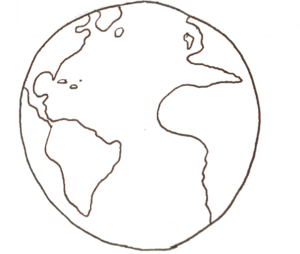How Can You Help Fight Climate Change?
November 10, 2021
Here is the world.
Here is the world in a pressure cooker.
It’s called science!
You’ve likely been following the headlines about the UN Climate Change summit (COP26), the most consequential gathering of world leaders since the Paris Agreement. Or Big Oil’s decades long climate misinformation campaign.
These stories come on the heels of a report released by the United Nations’ Intergovernmental Panel on Climate Change that offered the most up-to-date physical understanding of climate change and issued a ‘code red’ for the planet.
It’s enough to want to crawl under your blanket and watch TikTok videos until you lose track of time and space.
Well, the good news is there are better things we can do.
I know that when looking for ways to help it can feel overwhelming to sift through the sheer volume of information on the internet.
So here I’m going to keep it simple. And talk about 4 tangible steps you can take to help fight climate change.
Before I jump in, I’d like to make 3 notes:
- This will not be exhaustive. It’s a starting point from which to grow.
- No one person can fix climate change, and it won’t be solved overnight. Be gentle with yourself. Focus on what you can do, with what you have, where you are.
- We can all play a part in mitigating climate change, but when it comes down to it – individual shifts are not enough. Policymakers and corporations have the big levers to pull, and must be held accountable to do so.
Let’s do it!
1. Educate Yourself
The following are two newsletters I’ve found helpful. I know there are so many resources that deserve to be mentioned here, but again I want this to be digestible and doable. It’s also convenient that these are delivered to your inbox.
- Weekly newsletter “to expose and explain the forces behind past and present inaction on the most existential threat of our time.”
- Called one of the foremost climate journalists in the U.S., Atkin’s newsletter feels like peeking behind the curtain at what’s actually happening.
The Crucial Years by Bill McKibbin
- A newsletter about the climate crisis from someone who has covered it for decades.
- McKibbin is the co-founder of 350.org, journalist and author of over a dozen books about the environment, including The End of Nature (1989), the first book written on climate change for the general public.
2. Talk About It
With Loved ones: It’s often easier to avoid uncomfortable conversations, but one of the most important things we can do is talk about climate change with friends and family. People trust people they know and it helps spur collective action. Remember to come from a place of empathy and understanding.
- Here’s tips for having an emotionally intelligent conversation about it and some tools to help the conversation.
With Community: Climate change is a collective problem, that’s why collective action is so important.
- Tap into groups already working in your community or start a chapter yourself.
With your Representatives: Writing and calling your representatives tells them fighting climate change is important to their constituents. Get involved in local campaigns and vote for representatives that support climate action.
- First, find your representatives.
- Citizens Climate Lobby has tools to help you write and call your representatives.
- You could also see what town halls are happening in your city and attend one.
3. Make Tiny Changes to your Behavior
A good place to start is quantifying your carbon footprint. The University of California-Berkley’s CoolClimate calculator can help you. Take stock of your behavior and consumption habits.
Then there are a number of changes you can make to lower your individual carbon footprint, including eating less meat, driving less and walking, biking or taking the bus more, and avoiding fast fashion and buying less things.
- This article breaks down the different changes you can make. See what you can start with and try to chip away at it.
Carbon offsets are another option. It’s essentially investing in projects that reduce or capture greenhouse gases to compensate for personal emissions.
- This is a carbon offset calculator for flights.
- Wren is an interesting startup that helps you calculate and offset your carbon footprint.
4. Donate Money
There are many amazing nonprofits working to mitigate the impacts of climate change.
Below are 3 nonprofits we’ve supported on PennyLoafer, and why.
- What they do: push the change in technologies and policies needed to get to a zero-emissions, high-energy planet at an affordable cost.
- Why we chose them: CATF has a strong track record of achieving policy changes. They focus on realistic, scalable solutions to decarbonization. And their impressive team regularly contributes leading research to the field.
- For more, read their 2020 Report or this endorsement from Founders Pledge, a leading charity evaluator.
- What they do: partner with indigenous peoples in Central and South America to protect their rainforest ecosystems.
- Why we chose them: their work is evidence-based, cost-effective and scalable. RFUS recognizes that indigenous peoples are the best guardians of the forests and directly invests in those on the frontline.
- For more, read the CEO’s article about the urgency of this work.
- What they do: use off-grid solar installations to address energy access challenges and provide power to families on the Navajo and Hopi Nations.
- Why we chose them: Native Renewables is catalyzing clean energy for Native American families and communities, and building the technical capacity of the local workforce. They have strong leadership and focus on low-cost solutions.
- For more, read this interview with Ms. Singer, the now Executive Director.
If you like these nonprofits and are interested in a simple way to regularly support the planet, consider supporting the climate change cause on PennyLoafer, and let us do the work for you.
Each month, your donation will be combined with other supporters and sent to a vetted nonprofit addressing climate change. You’ll learn along the way via an informative monthly newsletter. We also don’t take any percentage of the donation, so that your money is going to the charities. Join us in creating a more sustainable world!

